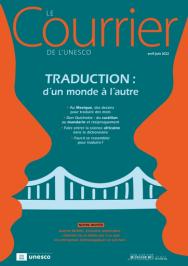Idea
Tell me what you eat, and I’ll tell you who you are

Gustavo Laborde
Doctor of Anthropology, specialist in the history and culture of food, he is professor at the School of Nutrition of the University of the Republic, Uruguay.
The act of eating is governed by a principle of absorption. The food we ingest has concrete biochemical effects in the body. This is why we literally are what we eat. But this aphorism also works the other way round – we eat what we are. Because, when we eat, we absorb not only nutrients, but also symbols and meanings. All cultures assign specific meanings to their foods – there are everyday dishes and festive dishes, main meals and snacks, things that are eaten and things that are not. Food not only weaves a web of meanings, it is also a central feature of collective and individual identities.
For the past thirty years these identities have been evolving, creating paradoxical eating behaviours. This ‘new food order’ is in fact traversed by two opposing movements. On the one hand, we are witnessing the globalization of a standardized diet ‒ often called ‘Western’ ‒ based on an abundance of meat products and processed foods, refined sugars, saturated fats and carbohydrates. On the other hand, more singularized diets are emerging, creating a mosaic of fragmented trends with increasingly personalized, ‘à la carte’ ways of eating.
We are witnessing the globalization of a standardized diet
This singularization has the effect of distancing us from traditions, so that we can play an active part in deciding our own eating habits. Today’s sophisticated consumer is able to consciously manipulate symbolic meanings with the specific aim of constructing their own identity. For consumption largely shapes our lifestyle today.
The ritual of the family meal
Few activities are as everyday as the act of eating. Yet this reiterated action is increasingly leading to a theatricalization of intimacy.
The ritual of eating together as a family around the table in front of the television is now largely a thing of the past. As the number of screens increases, eating habits are becoming more fragmented. It is not unusual to see members of the same household having dinner, each in front of their own screen and with their own individual meal – a plate of vegetables for the vegan, gluten-free food for the coeliac, vitamin supplements for the sporty one, a barely reheated ready meal for the one who lacks the time or the desire to cook.
This diversity of ways of eating betrays a distancing from culinary traditions that once conferred collective identities on the various regions and nations of the world. Many people today eat differently to their grandparents, even their parents. However, this does not mean that collective identities are dissolving, they are simply changing. By adhering to a particular diet, individuals deploy identities that transcend family, region, or country, to become part of networks of transnational communities.
Networked eating
At the same time, commensality – the way in which a meal is shared – is being enriched by new practices. A few years ago, a phenomenon called mukbang, a Korean term that melds together ‘eating’ and ‘broadcasting’, was born in certain Asian societies. This practice consists of eating a sometimes-impressive quantity of different foods in front of a video camera while interacting with a connected audience. As many people eat their meals alone, this phenomenon may be a response to the need to invent a new, virtual commensality. Nowadays, we also eat in networks.
Eating behaviour, central to collective and individual identities, is changing
The singularization of diet is often a matter of choice. The individual decides whether to be vegetarian or omnivore, to eat organic, local, or seasonal produce, whether to eat unhealthy but comforting food, to be a gourmet or a detoxer. The reasons for these choices may be moral or dictated by the need to adapt one’s diet according to pathologies, intolerances, or food refusals. They also reveal the medicalization of food. According to an economic logic that tends to commercialize every aspect of life, market players have converted certain foods into ‘remedies’ that fight diseases, facilitate digestion, are antioxidant, or prolong life.

Enhancing the experience
Indeed, eating has become an experience. The satisfaction of this desire has increasingly become an adventure of the self, into which people invest their money, their cultural capital, and above all the search for their own identity.
Consumer culture encourages exoticism and novelty. Certain products thus acquire greater economic value if they pass into a sphere of consumption where they are invested with labels linked to the rhetoric of authenticity, as being ‘ethnic’, ‘artisanal’, ‘heritage’, or ‘natural’. Examples include quinoa from the Andes, Pu-erh tea from China’s Yunnan province, artisanal cheese from the Pyrenees, and beef from natural pastures in Uruguay.
In the same vein, tourism offers one of the most dynamic forms of gourmetization and the satisfaction of the need for exoticism. Travellers have the chance to enjoy a vast range of unique gastronomic experiences. In this respect, a growing number of countries are keen to develop so-called gastrodiplomacy, a strategy that uses local food as a lure to attract visitors. This strategy works in two ways to stimulate the economy and local development. It not only attracts tourists to the country, but also confers on its products and chefs a brand image that functions as a label of quality abroad.
However, gourmetization can also be obtained through more artisanal processes. Faced with the massification of consumer goods standardized by industry, people are now looking for products that stand out. In today’s society, cooking has become an object of consumption – it is no longer a heavy domestic burden, but a glamorous and recreational pastime. Growing vegetables for your own consumption, buying fair-trade coffee beans, preferring organic produce, or preparing homemade kombucha is more than just a gourmet attitude. Through these forms of creative consumption, foods also express aesthetic, political and above all, identity-related positions.
These new practices are not without certain adverse effects. When quinoa entered the gourmet market, for example, indigenous communities in the Andes, who base their diet on this seed, saw their access to a traditional food seriously compromised. Meanwhile, the medicalization of food is largely illusory, even misleading. Another pitfall is that the destruction of commensality is eroding the social bonds that sharing food reinforces.
Despite these limitations, cuisine is remarkably resilient, constantly capable of reinventing itself. It remains the centre of social life and continues to forge identities. It remains a shared code ‒ materially and now virtually ‒ and a very powerful system of communication.














